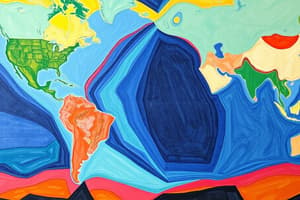Podcast
Questions and Answers
What is the primary relationship between plate tectonics and the formation of mountains and ocean basins?
What is the primary relationship between plate tectonics and the formation of mountains and ocean basins?
Plate tectonics explains that the movement of tectonic plates creates mountains and ocean basins due to variations in the density and thickness of the crust.
How does the density of continental crust compare to oceanic crust, and what effect does this have on their positioning?
How does the density of continental crust compare to oceanic crust, and what effect does this have on their positioning?
The continental crust is thick and made of low-density rock, allowing it to float higher, while the oceanic crust is thin and high-density, causing it to sit lower in the mantle.
Explain the term 'asthenosphere' and its role in the movement of tectonic plates.
Explain the term 'asthenosphere' and its role in the movement of tectonic plates.
The asthenosphere is a soft, pliable layer of the upper mantle that allows the lithosphere to move on top, facilitating tectonic plate movement.
What historical work did Abraham Ortelius contribute to the theory of plate tectonics?
What historical work did Abraham Ortelius contribute to the theory of plate tectonics?
Describe the concept of Pangaea and its significance in the study of plate tectonics.
Describe the concept of Pangaea and its significance in the study of plate tectonics.
What evidence do patterns of earthquakes and volcanoes provide concerning tectonic plate boundaries?
What evidence do patterns of earthquakes and volcanoes provide concerning tectonic plate boundaries?
How does the lithosphere interact with the asthenosphere?
How does the lithosphere interact with the asthenosphere?
In what way did Alfred Wegener's theory of continental drift support later developments in plate tectonics?
In what way did Alfred Wegener's theory of continental drift support later developments in plate tectonics?
Flashcards are hidden until you start studying
Study Notes
Plate Tectonics Overview
- Scientific theory explaining the creation of landforms through Earth's movements.
- Earth's crust consists of seven large tectonic plates and several smaller ones.
Earth's Structure
- Comparison: Earth's cooling process likened to a grape shrinking into a raisin, forming mounts and ridges.
- Continental crust is thicker and lower in density, causing continents to rise above the ocean surface.
- Oceanic crust is thinner and denser, leading to ocean basins being situated below the ocean surface.
Geological Patterns
- Locations of major geological features such as mountains, ocean trenches, and earthquake zones follow distinct patterns.
- The lithosphere comprises the outer layer of the Earth, including the crust and the upper mantle, with a thickness of about 100 km.
- Nutrient provision for plants and various rock types from the rock cycle occur within these layers.
Asthenosphere Characteristics
- Lies beneath the lithosphere; solid yet softer due to high pressure and temperature.
- Behaves plastically, allowing it to flow while supporting the movement of the lithosphere.
- Tectonic plates move annually at rates between 1 cm to 15 cm.
Historical Context
- Development of plate tectonics theory is attributed to foundational works by Abraham Ortelius.
- "Theatrum Orbis Terrarum" is noted as the first world atlas, depicting coastlines of Africa, Europe, and America.
- Alfred Wegener proposed the Theory of Continental Drift, introducing concepts such as Pangaea (supercontinent), Laurasia, and Gondwanaland during the Permian Period.
Major Global Features
- Panthalassa represents the vast oceans that surrounded Pangaea, emphasizing the interconnected nature of Earth’s geography.
- Understanding plate tectonics enhances insights into Earth's geological patterns and phenomena.
Studying That Suits You
Use AI to generate personalized quizzes and flashcards to suit your learning preferences.




